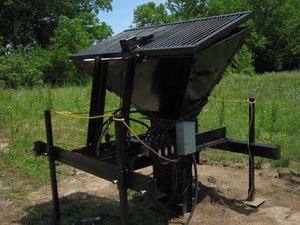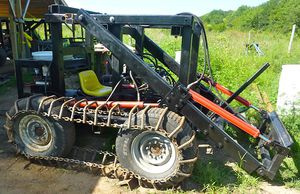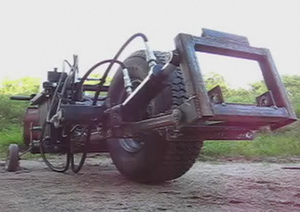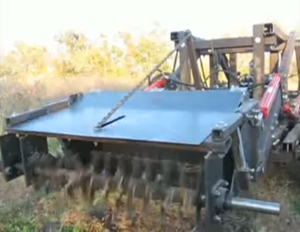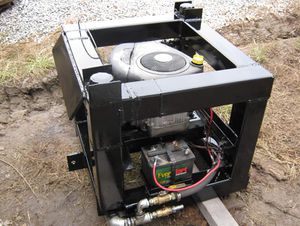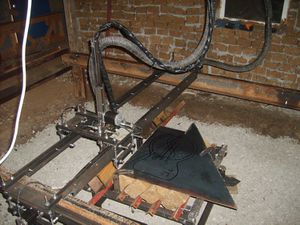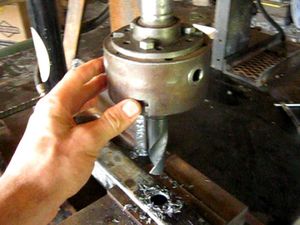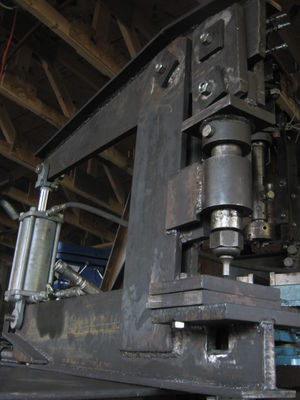Crash course on OSE: Difference between revisions
| Line 105: | Line 105: | ||
|The Ironworker Machine is a device that can instantly cut steel and punch holes in metal thicknesses of 1". Currently the 150 Ton Hole Puncher is prototyped. | |The Ironworker Machine is a device that can instantly cut steel and punch holes in metal thicknesses of 1". Currently the 150 Ton Hole Puncher is prototyped. | ||
''Links'': [http://openfarmtech.org/weblog/2010/07/open-source-150-ton-hole-puncher/ 150 Ton Hole Puncher's blog post] | ''Links'': [http://openfarmtech.org/weblog/2010/07/open-source-150-ton-hole-puncher/ 150 Ton Hole Puncher's blog post], [http://sketchup.google.com/3dwarehouse/details?mid=76574afca0dc2a81211da1f85706ccd Sketchup model] | ||
''Documentation'': {{LinkLang|Ironworker|Hole Puncher's Wiki | ''Documentation'': {{LinkLang|Ironworker|Hole Puncher's Wiki Documentation}}, [[:Category:Ironworker|Wiki Category]] | ||
|} | |} | ||
Revision as of 05:37, 16 January 2012
| Crash Course This is a Crash Course on Open Source Ecology (OSE). In the next 15 minutes, you will be brought up to date on all the work of OSE from the last 4 years. Email crashcoursemoderator at gmail dot com for support. See also Technical Abstract of the GVCS. |
Overview for New People
Start with our Main OSE Website.
To see what we do, see the GVCS in 2 Minutes video. Open Source Ecology was founded in 2004 by Marcin Jakubowski. We are a network of farmers, engineers, and supporters that for the last two years has been creating the Global Village Construction Set, an open-source, low-cost, high performance technological platform that allows for the easy, DIY fabrication of the 50 different Industrial Machines that it takes to build a sustainable civilization with modern comforts. The GVCS lowers the barriers to entry into farming, building, and manufacturing and can be seen as a life-size lego-like set of modular tools that can create entire economies, whether in rural Missouri, where the project was founded, in urban redevelopment, or in the heart of Africa.
See logs of the on-site participants at Factor e Farm.
We have an ambitious program for product release of the 49 remaining technologies within 2 years and a 2.4M dollars budget - which we abbreviate as our 50/2/2 program. The period for this is 2011-2012.
Key Features of the GVCS
These are the Key Features of the GVCS, and if you want to see the full set of values, see Core Values of OSE.
Key Features
|
Scope of the GVCS
Scope
|
Current Status
last updated: 19. August 2011.
The following prototypes and products are developed until now:
| The Compressed Earth Brick (CEB) Press allows for rapid (16 brick per minute), low-cost, high-quality construction from on-site earth. The CEB Press is used to compress clayey soil (20-30% clay by volume) from local or on-site soils into structural masonry (700-1000 PSI) building blocks. Stabilization with cement may be used for additional weather resistance. CEB also lends itself to the construction of floors, paved areas, retaining walls, storage structures, or any other structures where a uniform, structural building block is desired.
Links: The Liberator, The CEB Story, initial field testing, pressing bricks, disassembly, crating (packaging), machine overview, the frame, the controller, CEB Machine Controller: Fabrication Recursion, Complete CEB Walkthrough. Documentation: Introduction, Build Instructions, CAD Files | |
| LifeTrac is a versatile, 4-wheel drive, full-sized, hydraulically-driven, skid-steering tractor of 18-200 hp with optional steel tracks. LifeTrac is intended to be a minimalist but high-performance, lifetime design, design-for-disassembly workhorse and power unit of any land stewardship operation. It features easy serviceability by the user. Its modular nature allows for quick attachment of implements; interchangeability/stackability of multiple power units (Power Cubes) for adapting power level to the task at hand; quick attachment of all hydraulic components via quick-coupling hoses; including quick interchangeability of hydraulic motors for use in other applications.
Links: Prototype I; Prototype I with external Power Cube; Prototype II of Development, Prototype II Completed, moving. Prototype III. Prototype IV. Documentation: Build (wiki page with videos), Blender Files; Quick Attach Plate and Tracks CAD | |
| MicroTrac is a scaled-down, walk-behind version of the the full-sized LifeTrac to address the need for a microtractor. We are using most of the same components as LifeTrac, except we are shrinking the structural members – to retain part interchangeability between MicroTrac and LifeTrac.
Links: Prototype I completed blog post, prototype I completed video, zero turn, Microtrac Prototype II, Prototype II Challenge. Documentation: wiki documentation ; Prototype I Blender File | |
| The Soil Pulverizer can be attached to LifeTrac and pulverizes the soil to a fine consistency which can be used in preparation for pressing Compressed Earth Bricks (CEBs).
Links: blog, construction and test (short video), test (video). | |
| The Power Cube is an universal, self-contained power unit that consists of an engine coupled to a hydraulic pump for providing power to different devices in the form of hydraulic fluid at high pressure. The Power Cube is a module that can be attached to the LifeTrac, Microtrac, Bulldozer, and Open Source Car (OSCar) platforms. It connects to other devices via quick couplers and quick-connect hydraulic hoses.
Links: short and long (50min) video. Documentation: Blender Files. | |
| CNC Torch Table is a cutting table. A computer can control the torch head making clean sharp cuts on XYZ axes. Prototype I has been built, but has not been operated successfully because the radiation emitted by the plasma cutter that was used with the table caused electronics failure. We will finish Prototype I by retrofitting it with open source stepper motor controllers.
Links: wiki page, Plasma cutter in action, Open Source Torch Table Part 4, Part 5, Part 6. Documentation: Build (wiki), Blender File; Prototype I First Fire | |
| The Drill Press is for drilling 1″ and larger holes directly in metal without pre-drilling. It contains a hydraulic motor for the drilling and a hydraulic cylinder for the down pressure – so this is a literal press, and it is not short on torque or power as the motor can sustain up to 20 hp. We are using our Universal Rotor for the motor.
Links: video Documentation: documentation | |
| The Ironworker Machine is a device that can instantly cut steel and punch holes in metal thicknesses of 1". Currently the 150 Ton Hole Puncher is prototyped.
Links: 150 Ton Hole Puncher's blog post, Sketchup model Documentation: Hole Puncher's Wiki Documentation, Wiki Category |
Currently we are prototyping:
In March 2011, Marcin gave a TED Talk. Since then, the project is exploding.
We finished 4 orders of CEB Presses, Tractors, Power Cubes and Soil Pulverizers. Now we are in the middle of HabLab and Workshop construction.
Construction business using the Tractor-Soil Pulverizer-Compressed Earth Brick (CEB) Press package will start in Los Angeles by an early adopter, Joskua Designs. This will be the first field testing outside of Factor E Farm. The building project in California will have to deal with earthquake codes.
Currently, there are 3 independent efforts to replicate production of CEB Presses (James Slade, Brianna Kufa), tractors, and Power Cubes (Tom Griffin, Tom's Log).
Support us in our Kickstarter campaign. This Kickstarter push is aimed at the full testing, publishing, and deployment of the construction toolkit - the Tractor, Compressed Earth Brick Press, Soil Pulverizer, and Hydraulic Power Unit.
You can preorder the GVCS machines.
Future Plans
We are focusing on demonstrating the effectiveness of our equipment in construction and agriculture duties. For construction, we will be using the open source tractor, CEB press, sawmill, and other supporting tools such as soil pulverizer, cement mixer, auger, backhoe, trencher, hay baler, hay rake, hay cutter, and others. We will demonstrate infrastructure building and housing construction – including double CEB walls filled with strawbales for super-insulation.
We got a construction grant of 60k. You can check the GVCS Rollout Plan.
We get a Dimensional Sawmill prototype by Sweiger.
We are recruiting a Fabrication Manager and Construction Manager, and producing a site survey and architectural plans - assuming a budget of up to $100k dedicated to construction. We are further securing a rental unit in Maysville to house 1-2 onsite participants. We further have a documentation team on site, consisting of 2 dedicated people, who are working on full fabrication procedure documentation. We are currently securing our own server for video uploads, CiviCRM, and the ability to handle a large number of hits from Kickstarter. On video, we have almost 1TB of video footage from this production run, to be deployed to a remote video editing team - with a goal of professional quality instructionals on the CEB Press, Tractor, Soil Pulverizer, and Power Cube to be delivered as part of our Christmas Gift. On the legal front, we are trade-marking our identity and donating our land holdings into a trust.
We are looking for active collaboration in all projects. Our current needs are:
- Fabrication Manager - finish the existing and continue new production runs, produce further construction equipment necessary for infrastructure buildout. We are planning on prototyping the sawmill, cement mixer, auger, trencher, and backhoe in the 2011 season.
- Construction Project Manager- leading the building new of infrastructure as new people come on site, focusing on natural building techniques such as CEB, local lumber, and local biomass for superinsulation, and bioplastic for greenhouses (see last blog post for details)
- 3 Project Managers – overall global/local project management and integration– utilizing the assistance of a global development team to move forward the creation and testing of the GVCS infrastructure at Factor e Farm
- Machine Designer/CAD – feeds technical design (CAD) into the prototyping process for the GVCS – by providing fabrication drawings to the fabrication team
- 4 Fabricators – custom fabricators and prototypers who convert technical design drawings into physical prototypes – creating the physical substance of the project
- CAM Expert – contributes to the CAM (fabrication automation) aspect of the prototyping process by developing CAM files and by using CNC machines – while streamlining the fabrication process
- Power Engineer – develops the electrical power grid for the community and develops the workshop power supplies – including developing the welder, plasma cutter, induction furnace, inverter, charge controller, and other power electric devices that are included in the GVCS
- Remote Collaboration Support – organizing remote contributor teams for design/CAD/prototyping assistance to Factor e Farm
- CAD/CAM Programmer – A robust, integrated, open source, professional-quality tool chain for CAD/CAM is currently not available. We will put effort into developing such a tool chain to promote the replicability of GVCS tools, by building on and integrating existing tools.
- Land Regeneration Manager – Factor e Farm suffers from serious erosion and fertility issues caused by decades of prior commercial row-cropping. To ameliorate this, our program calls for building berms, ponds, and other earthworks to address erosion directly, plus, extensive mulching, as well as intensive rotational grazing as a rapid way to improve the soil food web. The primary tools that are to be used in these tasks are bulldozers, ruminants, and hay-bales.
- Farmer – or more specifically – the open source agroecologist – the pivotal person in the community who provides nutrition to the FeF team and thereby is the primary contibutor to the good health of the community. The open source agroecologist is responsible for food production – from garden and orchard to field crops, animal husbandry, fishery, and forestry – and for food storage and processing, such as seed cleaning, seed saving, and oil expression. The farmer is responsible for producing food, fuel, and fiber crops (both wood and clothing) – while maintaining a diverse and integrated ecosystem and soil food web that improves in quality over time.
- Cook – feeds the FeF population; engages in crop planning, harvest, and organization of food processing activities
- Web Programmers and User Interface Designers can help with the True Fans Development Proposal.
- check our Project needs.
2012
2012 is rapid parallel development for the completion of the 50 machines. The greater global effort beyond FeF could help tremendously by identifying a large team of qualified, remote developers. Success on the overall 50 machines requires that we recruit a team of bidders/designers/prototypers for each machine – as each machine goes through a multi-step development process from concept to field testing and iteration. This enables us to access large sources of funding. Without a deployment team, we cannot take in money. Thus, if we have a solid team of bidders/designers/prototypers – and their capacities are clear – then we are in a position to move rapidly.
after 2013
After the GVCS completion the first OSE Community will be built and Education and Training in 2-year immersion program are planned.
A Documentary Film about Factory E Farm may come in the future.
Support OSE and collaborate with us to help us make this happen.
Getting Involved
| Get yourself involved! If you liked what you've seen, please check the Get involved page to see the various ways you can contribute your time and skills to our project |
If you want to join quickly some of the project, then check the Guide to OSE Projects.
Media and Interviews
For Interviews, please check our Press Procedure. Here you can find High Resolution GVCS Media.
Keywords
Required Reading for Developers
- OSE Specifications
- Proposal 2012
- GVCS Development Template
- Product Template
- Development Team
- Wiki Policy
- Forum Policy
Other
- Preorder the GVCS machines.
- Conferences
- Media Development
FAQs
To Do Items
See GVCS Tasks and Project needs.
